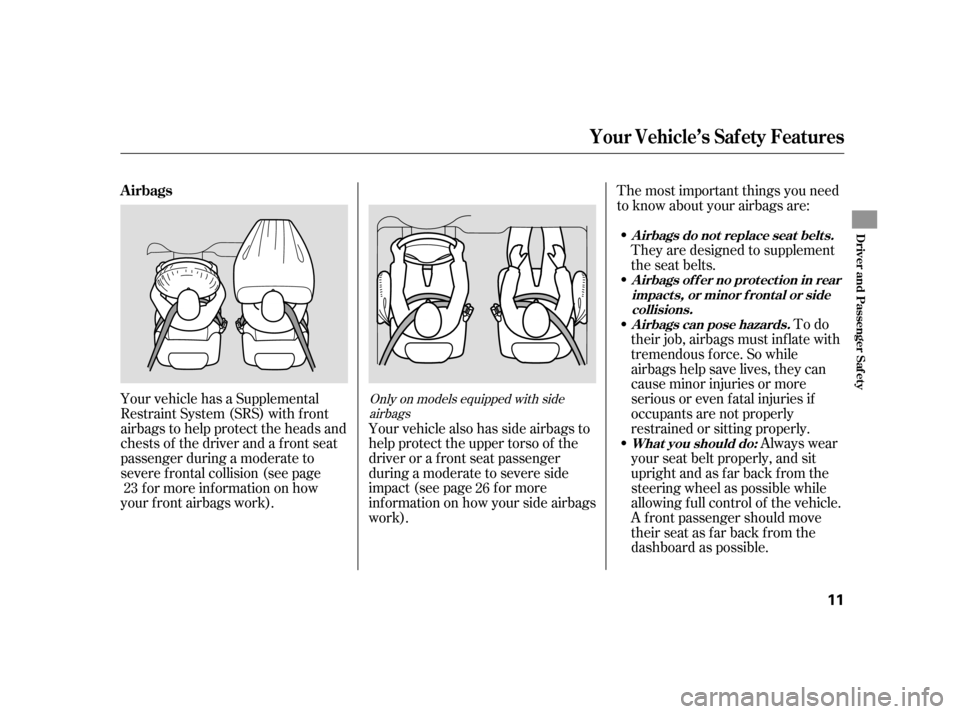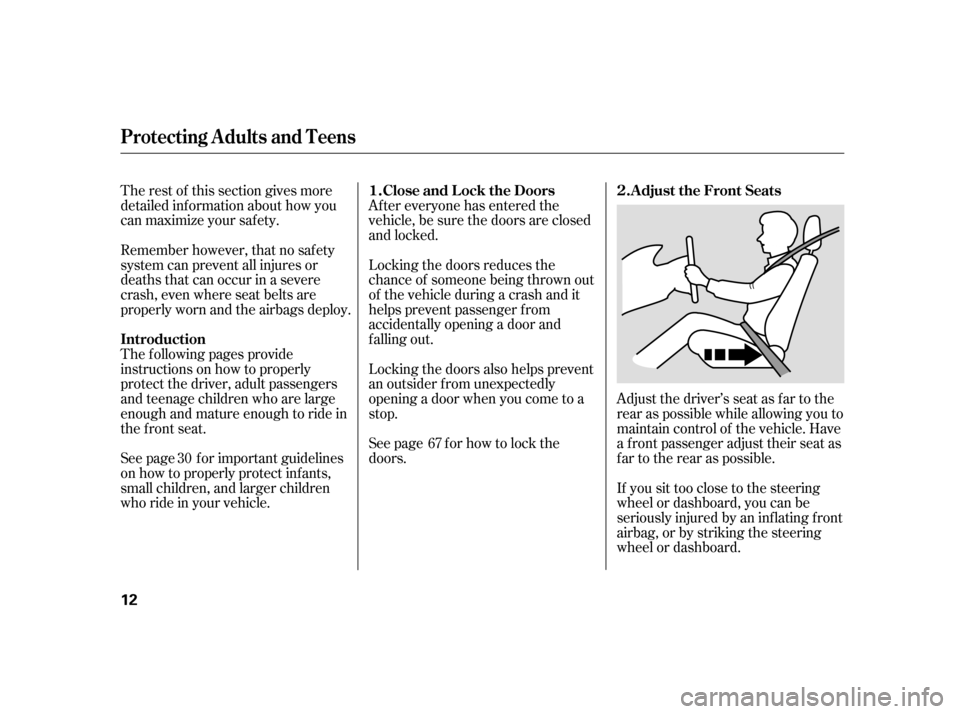Page 2 of 205
�Î
�ΠTo use the horn, press the center pad of the steering wheel.
:
Your Vehicle at a Glance
Your Vehicle at a Glance
5
WINDSHIELD WIPERS/WASHERS
REAR WINDOW DEFOGGER
HORN
TILT ADJUSTMENT
HEADLIGHTS/
TURN SIGNALS
CRUISE CONTROL
MASTER SWITCH
MIRROR CONTROLS
CRUISE CONTROL BUTTONS
(P. 61)
(P. 105)
(P. 79) (P. 60)
(P. 62)
(P. 62)
(P. 63) (P. 105)HAZARD WARNING BUTTON
�����—�����—�
���y�
���������
���y���
�(���)�������y���������y
Page 7 of 205

Only on models equipped with sideairbags
Your vehicle also has side airbags to
help protect the upper torso of the
driver or a f ront seat passenger
during a moderate to severe side
impact (see page f or more
information on how your side airbags
work). The most important things you need
to know about your airbags are:
They are designed to supplement
the seat belts.
To do
their job, airbags must inf late with
tremendous f orce. So while
airbags help save lives, they can
cause minor injuries or more
serious or even fatal injuries if
occupants are not properly
restrained or sitting properly. Always wear
your seat belt properly, and sit
upright and as f ar back f rom the
steering wheel as possible while
allowing f ull control of the vehicle.
A f ront passenger should move
their seat as f ar back f rom the
dashboard as possible.
Your vehicle has a Supplemental
Restraint System (SRS) with f ront
airbags to help protect the heads and
chests of the driver and a front seat
passenger during a moderate to
severe f rontal collision (see page
f or more inf ormation on how
your f ront airbags work). 23
26
Airbags
Airbags do not replace seat belts.
A irbags can pose hazards.
A irbags of f er no prot ect ion in rear
impact s, or minor f ront al or sidecollisions.
What you should do:
Your Vehicle’s Saf ety Features
Driver and Passenger Saf ety
11
�����—�����—�
���y�
�������������y���
�(���)�������y�����
���y
Page 8 of 205

The rest of this section gives more
detailed inf ormation about how you
can maximize your saf ety.
Remember however, that no saf ety
system can prevent all injures or
deaths that can occur in a severe
crash, even where seat belts are
properly worn and the airbags deploy.Af ter everyone has entered the
vehicle, be sure the doors are closed
and locked.
Locking the doors also helps prevent
an outsider f rom unexpectedly
opening a door when you come to a
stop.
See page f or how to lock the
doors.
If you sit too close to the steering
wheel or dashboard, you can be
seriously injured by an inf lating f ront
airbag, or by striking the steering
wheel or dashboard.
Locking the doors reduces the
chance of someone being thrown out
of the vehicle during a crash and it
helps prevent passenger f rom
accidentally opening a door and
f alling out.
Adjust the driver’s seat as far to the
rear as possible while allowing you to
maintain control of the vehicle. Have
a f ront passenger adjust their seat as
far to the rear as possible.
The f ollowing pages provide
instructions on how to properly
protect the driver, adult passengers
and teenage children who are large
enough and mature enough to ride in
the front seat.
See page f or important guidelines
on how to properly protect inf ants,
small children, and larger children
who ride in your vehicle.
30
67
Close and L ock the Doors A djust the Front Seats
Introduction 1.
2.
Protecting A dults and Teens
12
�����—�����—�
���y�
�������������y���
�(���)�������y�����
���y
Page 9 of 205
The National Highway Traffic Safety
Administration and Transport
Canada recommend that drivers
allow at least 10 inches (25 cm)
between the center of the steering
wheel and the chest.
If you cannot get f ar enough away
f rom the steering wheel and still
reach the controls, we recommend
that you investigate whether some
type of adaptive equipment may help.Once your seat is adjusted correctly,
rock it back and f orth to make sure
the seat is locked in position.
See page f or how to adjust the
f ront seats.
71
Protecting A dults and Teens
Driver and Passenger Saf ety
13
Sitting too close to a front
airbag can result in serious
injury or death if the front
airbags inflate.
Always sit as far back from the
front airbags as possible.
�����—�����—�
���y�
�������������y���
�(���)�������y�����
���y
Page 10 of 205
Adjust the driver’s seat-back to a
comf ortable, upright position,
leaving ample space between your
chest and the airbag cover in the
center of the steering wheel.
Passengers with adjustable seat-
backs should also adjust their seat-
back to a comf ortable, upright
position.Reclining a seat-back so that the
shoulder part of the belt no longer
rests against the occupant’s chest
reduces the protective capability of
the belt. It also increases the chance
of sliding under the belt in a crash
and being seriously injured. The
farther a seat-back is reclined, the
greater the risk of injury.
See page f or how to adjust the
seat-backs.71
Adjust the Seat-Backs
3.
Protecting A dults and Teens
14 Reclining the seat-back too far
can result in serious injury or
death in a crash.
Adjust the seat-back to an
upright position, and sit well
back in the seat.
�����—�����—�
���y�
�������������y���
�(���)�������y�����
���y
Page 19 of 205

Two SRS (Supplemental Restraint
System) f ront airbags. The driver’s
airbag is stored in the center of
the steering wheel; the f ront
passenger’sairbagisstoredinthe
dashboard. Both are marked ‘‘SRS
AIRBAG.’’
Automatic seat belt tensioners
(see page ).
Your Airbag System includes:
Emergency backup power in case
your vehicle’s electrical system is
disconnected in a crash.an
indicator on the dashboard that
alerts you that the passenger’s
side airbag has been turned of f
(see page ).
In models with side airbags,
sensors that can detect whether a
child is in the passenger’s side
airbag path and automatically turn
the airbag of f (see page ).
A sophisticated electronic system
that continually monitors and
records inf ormation about the
sensors, the control unit, the
airbag activators, the seat belt
tensioners, and driver and f ront
passenger seat belt use when the
ignition is in the ON (II) position.
An indicator on the instrument
panel that alerts you to a possible
problem with your airbags,
sensors, or seat belt tensioners
(see page ).
In models with side airbags, one
for the driver and one for a front
passenger. The airbags are stored
in the outer edges of the seat-
backs. Both are marked ‘‘SIDE
AIRBAG’’ (see page ).
Sensors that can detect a
moderate to severe front impact,
or side impact in models with side
airbags.
21
26 27
27 27
In models with side airbags,A irbag System Components
Additional Inf ormation About Your Airbags
Driver and Passenger Saf ety
23
�����—�����—�
���y�
�������������y���
�(���)�������y���������y
Page 54 of 205
�Î
�Î To use the horn, press the pad around the ‘‘H’’ logo.
Controls Near the Steering Wheel
Inst rument s and Cont rols
59
REAR WINDOW DEFOGGER
MIRROR CONTROLS TILT ADJUSTMENTHORN
HEADLIGHTS/TURN SIGNALS
WINDSHIELD WIPERS/WASHERS
(P. 61) (P. 60)
(P. 62)
(P. 105)
(P. 79) (P. 63)
(P. 62)
CRUISE CONTROL
MASTER SWITCH
(P. 105)
HAZARD WARNING BUTTONCRUISE CONTROL
BUTTONS
�����—�����—�
���y�
���������
���y���
�(���)�������y���������y
Page 58 of 205

Make sure the rear window is clear
and you have good visibility bef ore
starting to drive.
Thedefoggerwiresontheinsideof
the rear window can be accidentally
damaged. When cleaning the glass,
always wipe side-to-side.Push the lever up to lock the
steering wheel in that position.
Make sure you have securely
locked the steering wheel in place
by trying to move it up and down.
Move the steering wheel up or
down to the desired position.
Make sure you can see the
instrument panel gauges and the
indicators.
Make any steering wheel adjustment
bef ore you start driving.
To adjust the steering wheel upward
or downward:
Push the lever under the steering
column all the way down.
1.
4.
3.
2.
Rear Window Def ogger, Steering Wheel A djustment
Steering Wheel A djustment
Inst rument s and Cont rols
63
Adjusting the steering wheel
position while driving may
cause you to lose control of the
vehicle and be seriously injured
inacrash.
Adjust the steering wheel only
when the vehicle is stopped.
�����—�����—�
���y�
�������������y���
�(���)�������y���������y